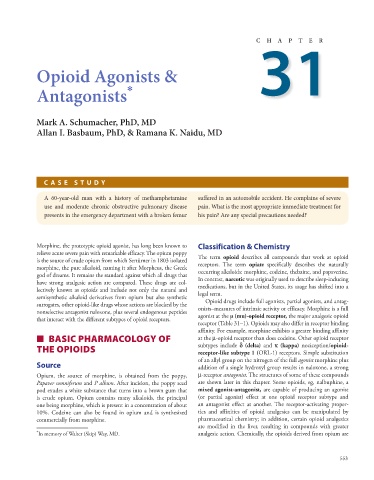Page 567 - Basic _ Clinical Pharmacology ( PDFDrive )
P. 567
C H A P T E R
Opioid Agonists & 31
Antagonists *
Mark A. Schumacher, PhD, MD
Allan I. Basbaum, PhD, & Ramana K. Naidu, MD
C ASE STUD Y
A 60-year-old man with a history of methamphetamine suffered in an automobile accident. He complains of severe
use and moderate chronic obstructive pulmonary disease pain. What is the most appropriate immediate treatment for
presents in the emergency department with a broken femur his pain? Are any special precautions needed?
Morphine, the prototypic opioid agonist, has long been known to Classification & Chemistry
relieve acute severe pain with remarkable efficacy. The opium poppy The term opioid describes all compounds that work at opioid
is the source of crude opium from which Sertürner in 1803 isolated receptors. The term opiate specifically describes the naturally
morphine, the pure alkaloid, naming it after Morpheus, the Greek occurring alkaloids: morphine, codeine, thebaine, and papaverine.
god of dreams. It remains the standard against which all drugs that In contrast, narcotic was originally used to describe sleep-inducing
have strong analgesic action are compared. These drugs are col- medications, but in the United States, its usage has shifted into a
lectively known as opioids and include not only the natural and legal term.
semisynthetic alkaloid derivatives from opium but also synthetic Opioid drugs include full agonists, partial agonists, and antag-
surrogates, other opioid-like drugs whose actions are blocked by the onists–measures of intrinsic activity or efficacy. Morphine is a full
nonselective antagonist naloxone, plus several endogenous peptides agonist at the μ (mu)-opioid receptor, the major analgesic opioid
that interact with the different subtypes of opioid receptors.
receptor (Table 31–1). Opioids may also differ in receptor binding
affinity. For example, morphine exhibits a greater binding affinity
■ BASIC PHARMACOLOGY OF at the μ-opioid receptor than does codeine. Other opioid receptor
THE OPIOIDS subtypes include c (delta) and j (kappa) nociception/opioid-
receptor-like subtype 1 (ORL-1) receptors. Simple substitution
of an allyl group on the nitrogen of the full agonist morphine plus
Source addition of a single hydroxyl group results in naloxone, a strong
Opium, the source of morphine, is obtained from the poppy, μ-receptor antagonist. The structures of some of these compounds
Papaver somniferum and P album. After incision, the poppy seed are shown later in this chapter. Some opioids, eg, nalbuphine, a
pod exudes a white substance that turns into a brown gum that mixed agonist-antagonist, are capable of producing an agonist
is crude opium. Opium contains many alkaloids, the principal (or partial agonist) effect at one opioid receptor subtype and
one being morphine, which is present in a concentration of about an antagonist effect at another. The receptor-activating proper-
10%. Codeine can also be found in opium and is synthesized ties and affinities of opioid analgesics can be manipulated by
commercially from morphine. pharmaceutical chemistry; in addition, certain opioid analgesics
are modified in the liver, resulting in compounds with greater
* In memory of Walter (Skip) Way, MD. analgesic action. Chemically, the opioids derived from opium are
553

